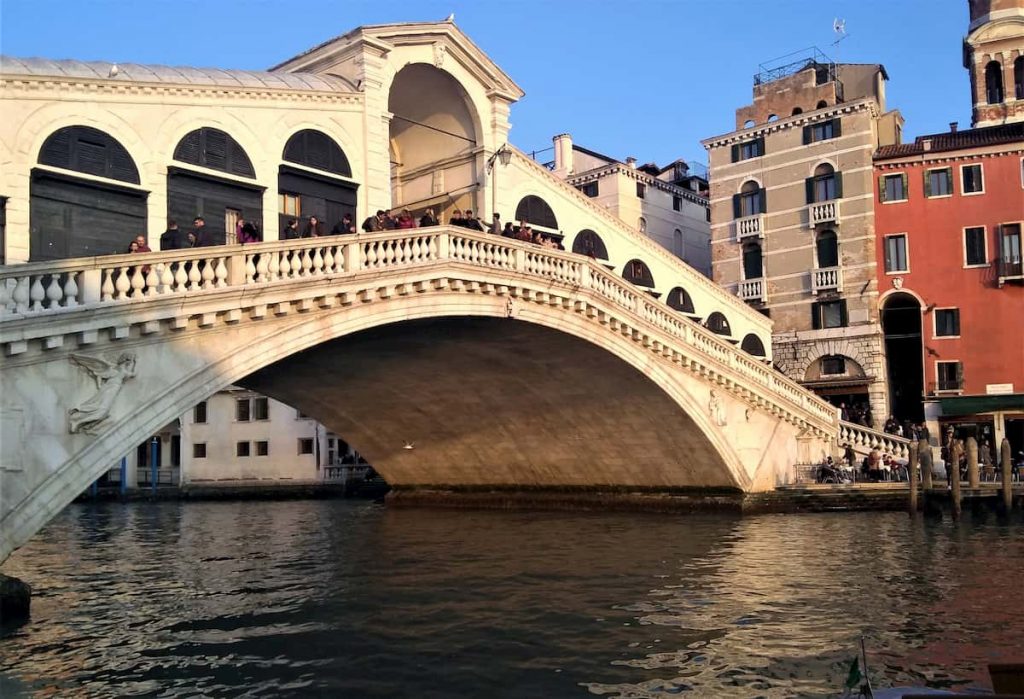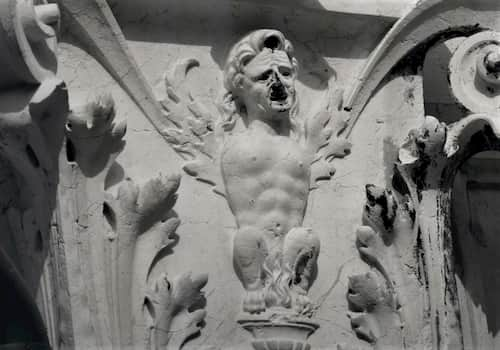When was the Rialto Bridge built… And why?
The first floating bridge over Canal Grande was built at Rialto in 1180. The Rialto bridge we see today is from 1591, and it was the only bridge over Canal Grande until 1854. The arch is a little short of 30 meters from one side to the other, 22 meters wide, the bridge’s total length is 48 meters, and it’s sustained by 12000 oak piles.

The project started in 1588, It was at the time seen as almost a miracle by God, building an arch that long. Proud and alone it stood for centuries right in the middle of Venice, all white and shiny. It had to wait until the middle of the 19th century before a companion was built. That’s when in 1854, a second bridge was completed to help get people from one side of Canal Grande to the other. That Bridge was Ponte dell’Accademia.
The reason to connect the two islands at that precise point was obviously that at Rialto, the food market resided there. The Venetians needed their fresh fruit, vegetables, fish, and meat every day, so some sort of connection between San Marco, and the food stands on the other side of the Canal was necessary.
The Quartarolo
Before the current bridge, many other constructions connected the San Marco side with Rialto. The first one was made already in 1180.
To join the banks of the canal to make the Rialto market more accessible they constructed a simple bridge of boats, laid side by side. Already in 1180 the project by Nicolò Barettiero stood ready. But it was a floating bridge and it by no means ideal. Although they could dismantle the bridge by simply moving the boats, it wasn’t a practical solution. When in place, it completely blocked the traffic on the canal. The name Quartarolo came from the fee the pedestrians had to pay for the crossing. Quartarolo was one-fourth of a Denaro… Anyway, a small coin.
The first real bridge

The floating bridge was deemed inconvenient. So a new bridge was built in 1264. This time the Venetians opted for a fixed wooden bridge The structure consisted of two inclined ramps that joined at a mobile central section, which could be raised to allow the passage of taller ships. Given the close association with the market, the bridge changed its name and became Ponte di Rialto, the Rialto Bridge in Venice.
In 1310, Bajamonte Tiepolo tried to overthrow the Doge in a Rebellion. It didn’t work out as planned and after he and his fellow revolutionaries had fled the scene, they crossed the Ponte di Rialto. After having done so he tried to tear it down and then burn it to prevent the guards from following. They didn’t completely succeed, but the bridge was severely damaged. It was rebuilt soon after.
After the reconstruction, that same bridge stood up for another hundred years until 1444. That summer, it collapsed when a big crowd gathered on top of the bridge to witness The Marriage cortege of the Marquis of Ferrara. 20 people died on that occasion.

Well, the bridge was rebuilt again, this time wider, stronger, and with shops on the side. Much like the present bridge. At this point, the Republic started to be concerned about the high cost of maintenance and the evident fragility of the wooden structure.
A stone bridge would be stronger, last longer, and resist fire
In 1503 a stone bridge was proposed for the first time, and in the following decades, several projects were evaluated. In 1514, Giovanni Giocondo projected a complete rehaul of the Rialto market. The city had grown and the various parts of the metropolis needed to be bonded together for everything to function in a rational way.
In 1524, another collapse occurred but it wasn’t until 1551 that the Venetian authorities launched a call for tenders for the reconstruction of the Rialto bridge. A commission of supervisors was appointed to validate the proposals. Now they had definitely decided to build the new bridge in stone.

During the second half of 1500 projects were presented by the most famous architects of the time, but only at the end of the 16th century did the doge Pasquale Cicogna announce a competition. Proposals came from architects such as Jacopo Sansovino, Andrea Palladio, and Giacomo Barozzi da Vignola, but they all proposed a classic approach with many arches. The competition was re-proposed in 1587 and Antonio da Ponte took part. He proposed a single-arch solution and this was the project that was finally chosen.
The Rialto Bridge in Venice was finally ready
The work was completed in 1591, thanks to the help of the architects Antonio, and Tommaso Contin da Besso.
Just like with any other huge financial project, there was some controversy. Antonio da Ponte was seventy-six years old at the beginning of the construction works. And he actually wasn’t really a supporter of the single Arch option. He was not young and adventurous anymore and would have opted for building a more traditional bridge. But his admirable restoration of the Doge’s Palace after the fire of 1577 had favorably impressed the officials. They wanted a single-arch bridge, and they wanted Antonio da Ponte to build it.
Antonio da Ponte – The constructer of the Venice Rialto Bridge

Da Ponte was actually only responsible for the construction of the Arch. He was not involved in the construction of the upper Bridge structures. Instead, these were made by Benedetto Banelli and Antonio Contin (the latter also worked on the construction of the Bridge of Sighs). Still, the Senate granted him the patent for the innovative technology used in the bridge. and nobody could sell paintings or drawings of the bridge for twenty years. It was copyrighted.
Maybe building the Arch of the Rialto bridge was the most complex and extraordinary enterprise of the whole project anyway. It is 28 meters wide, 7 1/2 meters high, and building that kind of structure in the Middle Ages was a huge task in any location. But building it in Venice with its Foundation of mud was extremely risky. 12000 wooden poles were used to keep the whole construction upright, 6000 on one side and 6000 on the other.
Problems occurred when trying to level the two sides. And since everything in Venice is moving about, great care had to be taken when laying the foundations at the Canal Sides. The central part of the Grand Canal was drained entirely for several months during the proceeding of the work.
How long and wide is the Rialto Bridge
The Arch is more than 28 meters (92 feet) from one side to the other.
It is 7,5 meters (25 feet) high at the center, at normal tide.
The width of the bridge is 22 meters (72 feet).
More characteristics of the Rialto Bridge
The bridge is flanked by shops in all its length. On the outer sides of the shops, there are more stairs. From here you can take photographs of the beautiful bloodstream of the city. The southern side, facing the straight canal towards Accademia, is one of the most Instagramable spots of the city. And it’s one of the most crowded.

The shops should be of prestigious type only. Actually, there’s an old decree that determines who can sell, and what can be sold on the bridge. And it has to be valuables… Gold and silver. Now, that is not the case anymore. The shops are not exclusively jewelry, but the city is moving in that direction. Controls are made, and fines are imposed every now and then to remove some of the most striking tourist traps.
The vagina in flames and the penis with a nail
The construction of the bridge took only three years but from the first plans till the bridge was ready almost 100 years had passed. This caused a great deal of ridicule and many bad jokes from the Venetians, all eagerly awaiting the new pathway to the other side.

There is a story about an elderly couple who stood gazing at the worksite. As they laughed at the impossible project the man uttered:
- sto ponte i lo finirà quando ch’el casso farà l’ongia (…This bridge will be completed when my penis grows a nail.)
The woman replied:
- quando che i finisse el ponte, me ciaparà fogo la mona (When they are ready with this bridge, my vagina will catch fire…)
A very colorful dialogue and without knowing it they became immortalized in two marble shrines on the Palazzo dei Camerlenghi, coming down from the bridge on the Rialto side and looking to your right.
The first shrine shows the woman, Mona (vagina), and the second shows the man, Casso (penis).
There are other legends about the impossibly long arch. A venture that seemed almost supernatural at the time. The most famous story explains how Da Ponte managed to finish the project without everything crumbling.